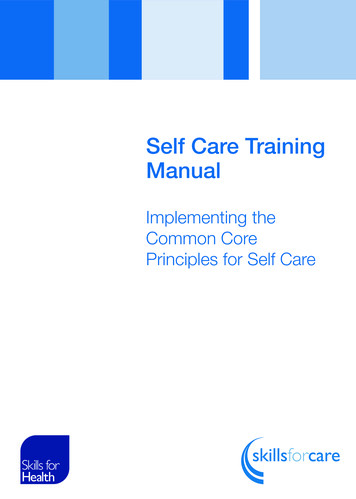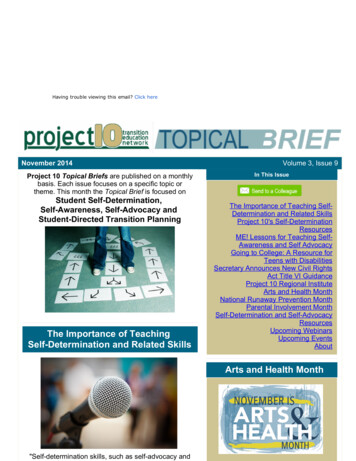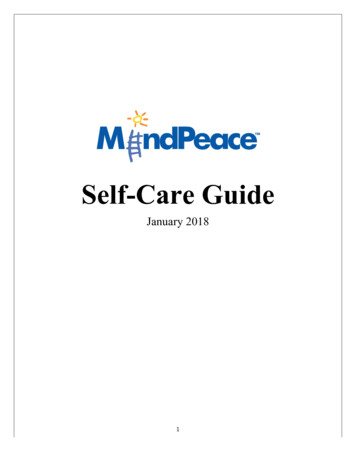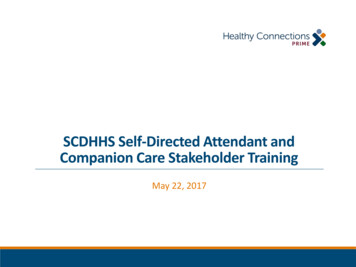
Transcription
Self Care TrainingManualImplementing theCommon CorePrinciples for Self Care
1
contentsPrefaceForeword01Acknowledgements05About the authors06Introduction07How the materials should be used08Guidance for trainers10Suggested training timetable11How to present module 112How to present module 214How to present module 318How to present module 423How to present module 527How to present module 637How to present module 741How to present module 846How to present module 948How to present module 1051Bibliography56041
prefaceThis training manual has emerged from aproject within the Skills for Care and Skills forHealth self care programme, as part of theNew Types of Worker programme.The training manual was developed withLancashire County Council’s ‘at home’ careservices. The objectives were to: design and test models of training inadopting and using the principles of selfcare across the workforce. embed the principles of self care withinthe health and social care workforcethrough management supervision, actionlearning and specialist mentoring. evaluate the results and outcomes of thetraining, particularly through a qualitativesurvey of a sample of workers, peoplewho use services, and carers. ensure that the sites share learning withinand across sectors for the duration oftheir funding.The brief was to: develop training to support self care usingthe Common Core Principles. test the training programme with staff,people who use services, and carers.The benefits of the work were: empowering people who use services tomake informed choices in managing theircondition and care needs more effectively. enabling workers to communicateeffectively with people who use servicesto develop and gain confidence in theirself care skills. enabling and supporting people to usetechnology in supporting self care.The work in Lancashire has been one of theprojects independently reviewed for us byCPEA Ltd, working with Sheffield HallamUniversity. They looked at team working,individual skills and attitudes, and how theorganisations (providers and commissioners)facilitated new ways of working to promoteself care. They found that Lancashire hadworked with jdee Consultancy to pilot atraining programme for front line care workersand developed a staff training manual linkedto individual budgets and self-directed care.This work is the basis for the present Self CareTraining Manual.The impact of the learning in Lancashire wassignificant. One member of the managementteam reported that the benefits to the staffwere that their role and value was recognised:“They felt empowered and more involvedwith their clients; they liaise with each other,work better as a team and motivation hasimproved.”Another organisation observed that absencelevels had decreased due to the new typeof working and that there was a feeling ofenhanced teamwork that was previouslyunknown.East Lancashire staff in another organisationwere reported by one care service registeredmanager as having changed from being1.
lone workers into a self-directing team whonow met to plan rotas, share learning andexchange information:“We have found the whole experience to bevery rewarding and it has provided us with aunique opportunity to develop our workforceto meet the future needs of our service usersand our commissioners.”Our projects in Lancashire and elsewherehave suggested that better ways of workingto promote self-directed care do not resultfrom training in isolation. The right conditionsinclude a willingness to engage with peoplewith long term conditions and their carers, andthe willingness of provider and commissionermanagers to see that their work has evolvedin ways that are not fully adapted to currentpolicy. They have to acknowledge that moreagile and targeted ways of working withpeople with long term conditions have an edgeover the blunt responses of large, hierarchicalorganisations.But while training might not be enough on itsown, it is certainly necessary. It was found tohighlight a lack of familiarity with ideas aboutencouraging self-management. After thetraining the staff reported they had learnedmore about long term conditions and believedthey were able to respond more sensitivelyin supporting people to self care. They alsoreflected that they were working differentlyand, in doing so, most found their work morestimulating.In addition, organisational change was keyin the Lancashire project, and was shownpowerfully in significant workforce andorganisational changes that occurred for oneparticular service provider. That organisationhad been centrally controlled, worked rigidshift systems and spent a great deal of timeensuring that staff attended to specifiedcontract directions. As a result of the pilot,structures have evolved so that a staff team‘cluster supports’ a group of people. Thiscluster is engaged in organising rotas thatdeliver continuity of cover to clients; it alsohosts fortnightly team meetings with a clientfocus.One of the constraints put forward by all homecare providers was the bureaucratic systemsoperated by the council. Contracts that wereresolutely output-focused, social workersinsufficiently attuned to the flexible use ofsupport hours, unduly protracted processesfor people to secure individual budgets, andweb-based bidding systems for tenders wereall perceived as obstacles to the provision ofpersonalised services. Irrespective of suchchallenges, one staff member noted:“I am much happier now that our work isplanned. Although I have to travel further ina day, I visit the same people and this helpsus work together on long term plans so weachieve more in our time. Also, one of the bestthings is not being contacted by ‘the office’everyday with changes!”2.
Impact on people who use servicesIn Lancashire 19 people who used serviceswere surveyed both before and after theprojectSome of the responses were:“I feel my care worker supports me to remainas active and independent as possible” upfrom 74% to 90%“My care worker understands my changingneeds and is flexible in supporting me to meetthem” up from 79% to 95%.“I feel my care worker understands my longterm health conditions and how they affectme” up from 73% to 90%“I set goals with my care worker in what Iwould like to achieve with their support” upfrom 47% to 74%“I am able to make decisions on how I amsupported by my care workers” up from 74%to 89%“I have been given information on technologyand/or devices which can support me in myhome” up from 31% to 79%.1It is clear from our work that self care trainingon its own is not the solution to change, but itis one component of the wider developmentrequired. For training to be successful, it islikely to have to be accompanied by a servicewide engagement with ‘what self-directedservices should be like’, including the will toengage with, and be highly responsive to,people who use services.And it is in this context, then, that Skills forCare and Skills for Health are pleased topublish this Self Care training package andcommend its use to the domiciliary careservices and trainers across the social caresector.Jim ThomasNew Types of Worker Programme lead,Skills for CareThis Self Care Training Manual issupported by:Angela Hawley, Self Care Lead, Department ofHealth.UKHCA3.
forewordLancashire County Council has been lookingto develop self-directed support that isavailable for people who will have their ownpersonal budgets but also within the servicesthat it commissions.Building on earlier work, the County Councilin partnership with Skills for Care and jdeetraining has developed both a TrainingManual for the training of care workers and aprogramme to introduce this across the wholeof Lancashire’s domiciliary care provision(approximately 100,000 hours per week).The manual and the way of working that itpromotes has proved extremely successful.Both users of services and care staff havereported benefits which include greater sayand control in service provision and increasedsatisfaction.The manual is a comprehensive and effectivetraining programme that clearly lays out howorganisations and individual care workers canprovide support that places the user at thecentre of the process.Mike WebsterHead of Procurement (Social Care)Adult and Community Services DirectorateLancashire County Council4.2
acknowledgementsSkills for Care and Skills for Health wish toplace on record its thanks to jdee Consultancyand Lancashire County Council for developingthis training material from work commissionedby the Skills for Care New Types of Workerprogramme.We would also like to pay a special thanksto Helen Dean, Suzanne Black, Lisa-MarieArkwright, Anita Ingham, Diana Parker, NatalieAshworth and Hayley Gregson.The work is published as from Skills for Care,but particular acknowledgement is due to thewriters at jdee Consultancy, namely ShaunDouglas Galley and Sarah Johnson.jdee Consultancy would like to thank thefollowing people and organisations who lenttheir time, enthusiasm and support to thedesign of this self care training pack.At Lancashire County Council: Mike Webster,Head of Procurement Social Care; JonBlackburn, Contracts Manager; EileenSingleton, Assistant Director Care ServicesOperations; Steve Sylvester, LocalityCommissioning Manager – Telecare ProjectsManager; Catherine Erwin, Self-directedSupport Manager.At Skills for Care North West, Sue George,Sub-Regional Co-ordinator GreaterLancashire.The care workers, people commissioningservices and their families and friends at AstraCare Services, Castle Care, Four SeasonsHomecare and Lancashire County CouncilIntake and Assessment Teams.5.
about the authorsShaun Douglas GalleyWith an honours degree in Social Policy andAdministration, Shaun has been working insocial care for the past 12 years, starting asa community support worker and working asa manager and national development advisorwithin domiciliary homecare. Since 2006 hehas worked to change the organisational focusof homecare providers and local authorities,and has a particular interest in developingpractical services that meet the agenda foruniversal self care and self-directed support.She has also been working to implementtraining programmes to support frontlinestaff to transfer existing skills and knowledgeinto new ways of working. Sarah acts asa consultant, teacher and advisor to bothservices and individuals.Contact: www.jdeeconsultancy.co.ukWith key project management experience,Shaun has been responsible for the integrationof outcome-focused services in line withthe personalisation agenda. In addition toresearch, he acts as a consultant and advisorto both services and individuals.Sarah JohnsonSarah has over 15 years’ experience in thenot-for-profit sector, designing, implementingand evaluating person-centred servicesboth locally and nationally across healthand social care. To meet the challenges ofthe personalisation of social care servicesSarah has been responsible for innovatingoutcome-focused models of self care anddeveloping monitoring and measurementtools to evidence the outcomes for individualspurchasing services.6.
introductionWelcome to the Self Care training manual.You may be thinking why do we need ‘new ways of working’ in social care and health?People who use health and social care services have asked for changes to be made to the waythey are supported, so they don’t have to fit in with what others want, but can direct their ownsupport services.So, this Self Care Training Manual is a new approach to supporting people in their own homes,so they can be involved, active and make personal choices that will begin to improve theirlifestyles. The approach is part of an overall programme of work at Skills for Care called ‘NewTypes of Worker’ and a linked programme at Skills for Health called ‘New Ways of Working.’Using this training manual is a fantastic opportunity for you to support health and social careworkers to build on their current practice, develop their knowledge and learn new skills, so theycan promote choice and control for the people they support. It will allow workers space to makesense of what is expected of them, and to support them to transfer their existing skills andknowledge into new ways of working.What will the new type of worker actually do? (We call them this; in reality they might have allsorts of different job titles).We want new types of workers to move away from just ‘doing tasks on the care plan’ to aworking environment where partnerships are formed, where using effective communication,gathering information and supporting people to set new goals in their lives, is part of everydaypractice.Having the skills to build confidence and motivate people to take more self care of their ownhealth and wellbeing will be a key responsibility for each new type of worker. We want theconcept of self care; where people learn new skills and gradually change their routines to bettercare for themselves, to be at the heart of community homecare.In order to make this happen, we will all have a part to play in working to improve the quality ofsupport delivered in people’s own homes, and your contribution starts here.7.
how the materials should be usedThe Self Care Training Manual has been designed to be used by trainers to support learners ingroups of up to 12 maximum, over a period of two days.The training can also be delivered to smaller groups of learners over a period of four weeks, as amodule-by-module training.In total there are 10 modules:Module 1: The role of the care workerModule 2: The future of homecareModule 3: Self care support – ‘doing it for ourselves’Module 4: Person-centred partnershipsModule 5: Long term conditions – the journeyModule 6: Effective communication and self careModule 7: Setting goals and overcoming challenges to self careModule 8: Gathering information and signpostingModule 9: Supporting people’s choicesModule 10: Supporting self care – assistive technologyModules 1 and 2 recognise the existing knowledge and skills that care workers have, whilstintroducing the changes that are being called for within health and social care so people cangain more choice and control over their support services.Module 3 introduces the concept of self care and self care support, and gets learners toconsider new ways of thinking, so they begin to involve people in better managing their ownhealth and wellbeing.8.
Module 4 focuses on the three keys to person-centred partnerships and outlines how toempower people so they can be at the centre of their support services.Module 5 outlines the emotional journey people may take when diagnosed with a long termhealth condition (LTC), and the symptoms they may face along the way.Module 6 introduces the ICE tool (ideas, concerns, expectations) so learners may use theircommunication skills to uncover individuals’ thoughts, feelings and the challenges they face.Module 7 places setting goals as the focus for supporting people to better self care, and giveslearners the skills they need to motivate and support people’s confidence to become moreinvolved in their own health and wellbeing.Module 8 outlines the importance of gathering appropriate information to support people tomake informed choices in their self care and outlines the self care support to which people canbe signposted.Module 9 considers how learners will need to work with people or their support networks toreduce risk, where reasonably practicable, so their choices may be upheld.Module 10 outlines the range of assistive technologies available to support self care.9.
guidance for trainersWithin this document you will find information on how to present the modules and a list of theworksheets and OHPs needed for each one. We advise that you print these off and keep themwith you as you facilitate learning, so you can keep to the suggested format and know when tointroduce the discussions and worksheets, which all include suggested feedback.You will find a copy of the OHPs and worksheets mentioned as separate documents atwww.skillsforcare.org.uk/selfcare. It is important that you photocopy enough worksheets prior toyour training sessions.In addition to this there are 10 separate documents with information on each of the modulesfor ease of use. These introduce each module and the content within it and are designed to beused when delivering the training.It is recommended that you take the time to read the supporting information within eachmodule, so you are confident that you have enough background knowledge and understandingto transfer learning consistently.When facilitating group discussions it is important that you use as much of your own knowledgeand experiences as possible and refer to the feedback outlined for each module if needed.Learners may be resistant to change and say ‘we do this already’, so be prepared andacknowledge their existing contributions, but remind learners that the new type of worker rolebrings with it new responsibilities to motivate people to self care. Once people have moreconfidence to ‘do more for themselves’, learners will have new opportunities to support them toachieve results in other areas of their lives.10.
suggested timetableThe self care training can be delivered over two days with groups of up to 12 learners, in aclassroom environment.An example timetable is included below as a suggestion for trainers.day 2day 19.30amIntroduction9.30amRecap on day 19.40amThe role of the care worker(Module 1)9.40amEffective communication and selfcare (Module 6)10.10amThe future of homecare(Module 2)11.10amTea/coffeeSetting goals and overcomingchallenges to self care (Module 7)11.40amTea/coffee11.25am12.00pmSelf care support – doing it forourselves (Module 3)12.25pmGathering information andsignposting (Module 8)12.45pmLunch1.05pmLunch1.45pmPerson-centred partnerships(Module 4)2.05pmSupporting people’s choices(Module 9)2.45pmLong term conditions – thejourney (Module 5)3.05 pmSupporting self care – assistivetechnology (Module 10)3.45pmGeneral discussion/reflection4.35pmGeneral discussion/reflection4.00pmClose4.55pmClose11.
how to present module 1Timing30 minutes includes discussion-varies with size of groupMaterialsFlipchart paper, marker pens, ‘Post It’ notesThere is one discussion in Module 1OHP’sOHP 1.1:OHP 1.2:OHP 1.3:OHP 1.4:OHP 1.5:OHP 1.6:OHP 1.7:Module 1: OutcomesDid you know?The vital role you playYour role brings with itThese responsibilities includeGroup discussion 1.1RememberDiscussions and WorksheetsDiscussion 1.1OHP 1.6 Group Discussion – ‘So what motivates you to be a care worker?’Aim: Learners will consider their motivations for working within community social care.Trainer: Ask each learner to write down one motivation on a Post It note; small groups to comeup with more than one. This discussion should be completed as a whole group, and should takeapproximately 10 minutes.Feedback: Trainer then gathers similar motivations together on flip chart paper and points outthe similarities and differences that the group has come up with.Motivations may include: ‘I like the people I support’; ‘Rewarding’; ‘Helping them to stay in ownhomes’; ‘Keeping people independent’; ‘Making a difference’; ‘I care about people’; ‘Alwayssomething different’; ‘Money’.12.
When you discuss the feedback with the learners, focus on the point that working in social careis often not for financial gain but rather wanting to ‘make a difference’ and to improve the qualityof life for people in their own homes. Working as a new type of worker will give learners anopportunity to extend their skills and better support people to monitor and manage their healthand wellbeing.13.
how to present module 2Timing1hr 30 minutes includes all discussions and activities - varies with size of groupMaterialsFlipchart paper, marker pens, Post It notesThere is one discussion and three activities in module 2OHP’sOHP 2.1:OHP 2.2:OHP 2.3:OHP 2.4:OHP 2.5:Module 2: OutcomesPopulation trendsThe Government’s messagePeople’s expectationsHow things work nowIntroduce Worksheet 2.1: Traditional Service – Mrs PattersonOHP 2.6:OHP 2.7:OHP 2.8:OHP 2.9:OHP 2.10:OHP: 2.11:OHP 2.12:The traditional care planGroup discussion 2.2In Control have some ideasIn Control’s principlesHow the new system will workKey – individual budgetsIndividual budgets mean more choicesIntroduce Worksheet 2.3: True or FalseOHP 2.13:OHP 2.14:OHP 2.15:Key - individual support planningWho does planning?Why plan?Introduce Worksheet 2.4: New Service – Mrs PattersonOHP 2.16:OHP 2.17:OHP 2.18:OHP 2.19:Inside an individual support planPlans don’t live in foldersNew types of worker responsibilitiesChallenges to the new system of homecare14.
Discussions and WorksheetsWorksheet 2.1Aim: Learners will explore how people may experience the current system of homecareTrainer: Split the learners into groups of 2 – 4 and give each group one Worksheet 2.1. Askthem to read through the worksheet, discuss and answer the questions, recording theiranswers. Depending on the number of groups ask each group to feedback on one question;make sure all questions are fed back. This activity should take approximately 20 minutes.Feedback: The key themes emerging from Worksheet 2.1Mrs Patterson may have felt uncomfortable with the assessment process, as similarquestions were asked of her by both social services and the homecare agency; often it isthe ‘professionals’ that assume control by approaching planning with tick boxes and rigidprocesses. Mrs Patterson could make few new choices in how she was supported, and anyrequests she did make were ‘immediately’ turned down and referred back to social servicesor the homecare office. She was told that making changes to her care plan was not allowed,without prior permission, again limiting her control.Discussion 2.2OHP 2.7 Group discussion - ‘If you could change the way you support people what would youdo?’Aim: Learners will come up with ideas about how the ‘way things work now’ could change forpeople using social care services.Trainer: Keep OHP 2.7 up for learners to see. Ask the whole group to think of how they wouldchange the current homecare system, if they could. Trainer to use flipchart paper to record allfeedback from learners. This discussion should take approximately 10 minutes.15.
Feedback: Take brief feedback from learnersChanges learners come up with may include: ‘being able to change what is on the care plan’;‘giving people more control over who provides their support’; ‘allowing people to make thechoices they want to’; ‘not putting people through more than one assessment’; ‘involvingpeople’s families more often’; ‘concentrating on what people want to do, rather than just on thethings they can’t’; ‘letting care workers plan with people.’When you discuss the feedback with learners, make the point that the current system needs tochange as it does not put people in control and makes care workers follow very set tasks ontheir care plans. This does not allow people to become involved in their own support or makenew choices about the things they want to do in their lives.Worksheet 2.3Aim: Learners will demonstrate their knowledge for the future changes being called for in homecareTrainer: Give all learners a copy of Worksheet 2.3. Ask them to answer each question on theworksheet; this should take approximately 10 minutes.Feedback: Trainer to read out the correct answers to worksheet 2.3, asking learners to marktheir own worksheets1.2.3.4.5.6.7.People are saying they are happy with the services they currently receive - FALSEPeople in our society are saying they want more choice and control over their services TRUEIn Control is an organisation that believes people can control their own services and befull citizens by using their individual budget - TRUEThe traditional way of providing care gives the person choice and flexibility - FALSEMany care workers are trained to follow the ‘care plan’, and are restricted from planningto do other things with the people they support - TRUEMaking changes to the care plan can be difficult as people need to be reassessed orpermission has to be sought through social services or the homecare provider - TRUEAn individual budget is where a person is offered an amount of money to spend on theirsupport needs - TRUE16.
8.9.10.11.12.The person has to manage their own individual budget, there are no other options -FALSEAn individual budget can mean that family, friends and other organisations can providepart of the support a person needs - TRUEHaving an individual budget will mean you can help people plan new goals, not on theircare plan, and achieve them - TRUEChanging to individual budgets is going to really easy for care workers and people beingsupported - FALSEAs a new type of worker, being positive about individual budgets will mean change willbe easier and people are more likely to get the best out of using them - TRUEWorksheet 2.4Aim: Learners will explore how people may experience the new system of self-directed support.Trainer: Split the learners into groups of 2 - 4. Give each group one Worksheet 2.4, ask them toread through the worksheet, discuss and answer the questions, recording their answers.Depending on the number of groups ask each group to feedback on one question; make sureall questions are fed back. This activity should take approximately 20 mins.Feedback: The key themes emerging from Worksheet 2.4Mrs Patterson is in control as she has an amount of money to purchase the services she wants.The assessment procedures are designed to take her choices and decisions into account andfocus on her abilities, what she can do and what she would like to do. Mrs Patterson is thecentral focus of her planning, taking her life experiences and likes and dislikes into account.The key benefits are that Mrs Patterson can now make changes directly with her care staff, andupdate her support plan when she wants to. Care staff also focus on building her confidenceand skills.17.
how to present module 3Timing60 minutes includes discussion and activities – varies with size of groupMaterialsFlipchart paper, marker pens, Post It notesThere is one discussion and two activities in module 3OHPsOHP 3.1:OHP 3.2:OHP 3.3:OHP 3.4:OHP 3.5:OHP 3.6:OHP 3.7:OHP 3.8:OHP 3.9:OHP 3.10:Module 3: OutcomesYour current roleThis develops your habit centresTraditional habit centres – the effectsWhat is self care?Health and well-bing is?Group discussion 3.1Balancing health and well-beingHow we are taught to self careAs older people?Introduce Worksheet 3.2: People’s own self careOHP 3.11:OHP: 3.12:OHP 3.13:OHP 3.14:OHP 3.15:OHP 3.16:Your new habits – self care supportAre people interested?Are people interested?What is stopping us supporting self care?What is stopping us supporting self care?Changing your thinkingIntroduce Worksheet 3.3: Your new way of thinkingOHP 3.17:OHP 3.18:OHP 3.19:Remember your new habitsYour new habit centres will:How are we going to make self care support happen?18.
Discussions and WorksheetsDiscussion 3.1OHP 3.7 Group Discussion – ‘What steps do you take to take to look after your health and wellbeing?’Aim: Learners will be able to describe different ways to look after their health and well being.Trainer: Keep OHP 3.7 up for learners to see, ask the whole group to think of the steps theytake to stay healthy and happy. This discussion should take approximately 10 minutes. Trainerto use flipchart paper to record all feedback from learners.Feedback: Take brief feedback from learnersSteps learners may come up with include: ‘eating good foods’; ‘drinking water’; ‘walking’;‘meeting friends’; ‘relaxing’; ‘not smoking’; ‘watching a good film’; ‘going to the gym’; ‘getting acheck up at doctors’; ‘holidays’; ‘dentist’; ‘weight loss’; ‘part of community’; ‘listening to music’.When you discuss the feedback with learners, make the point that we all take steps to look afterour own health and well-being. We are all responsible for making our own choices about howto stay healthy and happy, and at times we will seek information, advice and support from thedoctor, dentist, therapist, etc., to maintain our health and well-being. It is important that we canbalance our health and well-being so that we can avoid illness where possible and remain incontrol of our lives.Worksheet 3.2Aim: Learners will understand that people can self care without the support of care workers.Trainer: Split the learners into groups of 2 – 4. Give each group one Worksheet 3.2 and askthem to answer the question, recording their answers in the pie chart on the worksheet. Trainerto draw a copy of the pie chart on flipchart paper ready for feedback. Ask each group to feedback the points they have come up with. This activity should take approximately 15 minutes.Feedback: The key themes emerging from Worksheet 3.2‘going to the toilet’; ‘eating something’; ‘drinking fluids’; ‘watching TV’; ‘taking medication’;‘write letters’; ‘take a walk around’; ‘stretching’; ‘personal care’; ‘talking to friends and family’;19.
‘relaxing’; ‘washing dishes’; ‘cleaning’; ‘putting creams on’; ‘taking insulin’.When you discuss the feedback with learners, make the points that even though people mayuse homecare services, care workers are with them for only a few hours out of a 24-hour day,and people do take steps to self care when they are on their own. Even those people withlimited mobility will self care when alone.It is all too easy to assume that people rely on care workers to do everything for them.Worksheet 3.3Aim: Learners will acknowledge the impacts of their current way of working and explore newways of thinking.Trainer: Split the learners into groups of four. Give each group one Worksheet 3.3. Trainer toread instructions at the top of Worksheet 3.3 and explain what a consequence is – what mayhappen for the people if their care workers think in this way?Once learners have completed the worksheet, trainer to facilitate group feedback, and discussmain points raised with learners. This sh
self care. They found that Lancashire had worked with jdee Consultancy to pilot a training programme for front line care workers and developed a staff training manual linked to individual budgets and self-directed care. This work is the basis for the present Self Care Training Manual. The impact of the learning in Lancashire was significant.










